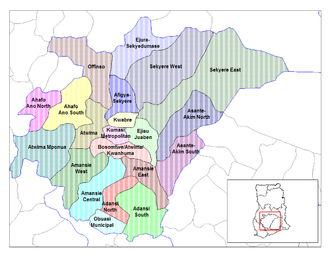Kwabre District
| Kwabre District | |
|---|---|

|
|
| country |
|
| region | Ashanti region |
| Capital | Mamponteng |
| District shape | common |
| District Chief Executive | Alhaji Kwesi Yeboah |
| surface | 356 km² |
| population | 164,668 (2004) |
| Population density | 463 Ew. / km² |
| ISO 3166-2 | GH-AH-KB |
The Kwabre District is one of 138 districts in Ghana . It is located in the center of the country in the Ashanti region and is one of 21 regional districts. The Kwabre District borders the Atwima Nwabiagya , Ejisu-Juaben , Sekyere East , Afigya Sekyere, and Kumasi Metropolitan districts . Chief Executive of the 356 km² district with approx. 164,668 inhabitants is Alhaji Kwesi Yeboah , based in the district capital Mamponteng .
geography
The vegetation is dominated by semi-humid forests. Grassland also takes up large parts of the district. Hardwood species used for export also grow in the forests. A major forest fire in 1983 destroyed large parts of the original rainforest areas. A stable secondary forest has already formed today.
population
83.5 percent of the population in the district belongs to the Akan peoples . About 10 percent of the district's population come from the peoples of northern Ghana.
politics
The district assembly of the Kwabre District (Kwabre District Assembly) is the highest authority in politics and administration. Until 1988, the Kwabre District was integrated in the Agona / Kwabre District with the seat of the district assembly in Agona. It was not until the Government of the Provisional National Defense Council (PNDC) established the Kwabre District with the Local Government Act 1993 Act 462 .
All other committees are coordinated and directed by an Executive Committee chaired by the Chief Executive. In the Kwabre District, the Economic Development, Social Services, Works, Finance and Administration, and Justice and Security committees have been appointed.
Other departments are in the areas of education, social welfare and community development, work, construction (physical planning), finance, disaster prevention, health, and agriculture (Agriculture) and the Specialized Unit of the Central Administration (Specialized Unit of the Central Administration) was established for the tasks of the Central Administration (birth and death registers, information service, statistical service).
There are eleven Area Councils in the Kwabre District. Four police stations in Mamponteng, Antoa, Kodie and Asonomaso were opened.
Throughout Ghana, the traditional rulers (chiefs) still play an important role in politics and especially in local politics. In today's Kwabre District, a special structure of chiefs has developed over the centuries. Some traditional rulers in the district are Abrempong and are committed to the Asantehene . A second group of traditional rulers is subject to the traditional rulers from Kumasi. A final group of traditional rulers in the district are subordinate to the Paramount Chiefs in Mampong or Nsuta .
health
In 1990, the immunodeficiency disease AIDS was diagnosed for the first time in the Kwabre District. In 2003, 23 cases of AIDS were found in the district's population; in 2004 the number rose to 72 and in 2005 to 84 cases.
Constituencies
There are two constituencies in the Kwabre district. In the constituency of Kwabre West, Emmanuel Asamoa Owusu-Ansah won the seat in the Ghanaian parliament for the New Patriotic Party (NPP) in the 2004 general election. Kofi Frimpong was elected by the NPP for the constituency of Kwabre East .
Important localities
See also
Web links
- Statoids
- ghanadistricts.com
- Ghanaweb, New Districts , (English)